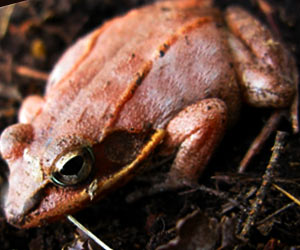The first evidence that African clawed frogs in California harbor a deadly fungal infection that is decimating amphibian populations across the globe provided by researchers in a new study.

"Our goal was to document historically how far back this fungus might have existed in California. Until this study, there were no reports to substantiate that Xenopus laevis (African clawed frogs) in California were infected with this fungus," said Sherril Green, PhD, DVM, professor and chair of comparative medicine at Stanford and senior author of the paper.
The Stanford scientists collaborated with colleagues at San Francisco State University on the study, which will be published May 15 in PLOS ONE.
The fungal pathogen, known as Batrachochytrium dendrobatis, has been implicated in frog epidemics in a number of countries, including the United States, United Kingdom, France, Spain, Germany, Portugal, Italy, Brazil and Japan, as well as throughout Latin America, said Green, who is a frog expert. Along with environmental pollution and loss of habitat, it's believed to be one of the factors behind the precipitous decline in worldwide frog populations.
African clawed frogs have long been suspected of spreading the dangerous pathogen, which is transmitted through the water. Spores from the fungus may tunnel into the animals' skin, causing skin thickening, electrolyte imbalance and brain swelling, Green said.
The African clawed frog was first brought to United States in the early 20th century for a somewhat unusual purpose: pregnancy testing. In the 1920s, it was discovered that injecting the frogs with urine from pregnant women would spur egg production in the animals. Hospitals then began routinely injecting frogs with the urine of female patients as a way to determine if the women were pregnant.
Advertisement
Today, the frogs are commonly used in biomedical research laboratories because they are hardy and long-lived and because they can continuously produce a large number of eggs, thus providing scientists with a steady supply of material for studies in developmental biology, medicine and physiology, Green said. However, because they are invasive and are not native to North America, their use, sale and transport are highly regulated in California and 11 other states, she said.
Advertisement
To determine their role in the spread of disease, the scientists examined 23 Xenopus specimens collected in California between 2001 and 2010, as well as 178 specimens collected in Africa between 1871 to 2000. All the specimens had been assembled by Stanford biologists, preserved in alcohol and donated to the California Academy of Science, which has one of the oldest and largest herpetology collections in North America.
Green and her collaborators, including co-author Stephen Felt, DVM, MPH, an assistant professor of comparative medicine, and three former Stanford undergraduates - Erica Morgan, Andrea Cowen and Sabrina Wilson, all members of the class of 2011 - spent hours in the basement of the academy combing through thousands of specimen jars and swabbing DNA from the skin of preserved frogs. They tested these samples using polymerase chain reaction, a simple, fast technique that allows DNA to be copied repeatedly. Among the African samples, five - or 2.8 percent - were positive for the fungus, including three from Kenya and two from Uganda, the researchers reported.
Among those samples from California, they found that three - or 13 percent of those tested - were positive for the fungus, including one frog taken from the Lily Pond in Golden Gate Park and two from San Diego.
The researchers documented the earliest positive case of the disease in a frog collected in Kenya in 1934, reinforcing the theory that the fungus was endemic to Africa long before the frogs were distributed worldwide as part of the live amphibian trade.
Now that the frogs are widely dispersed across the globe, Green said containing the epidemic is a major challenge.
"Right now people are still tracking what populations may be affected and may succumb a few years from now," she said. "Resistant species are surviving with chronic infections and will learn to live with it. While it wipes out most frogs that are not native or indigenous to the source of the fungus, some survive and there is hope that surviving populations will adjust and become resistant to it. But we don't have enough data to know indeed if that is happening."
The U.S. Fish and Wildlife Service has considered further restrictions on the importation and intrastate transport of the African clawed frogs, though Green said she does not believe such rules would have much effect on the current epidemic.
"In essence, it's like closing the barn door long after the horse has left," she said. "Further restricting Xenopus at this point is probably going to have very little impact on the ongoing epidemic, but will certainly have a negative impact on biological and biomedical research."
Source-Eurekalert









